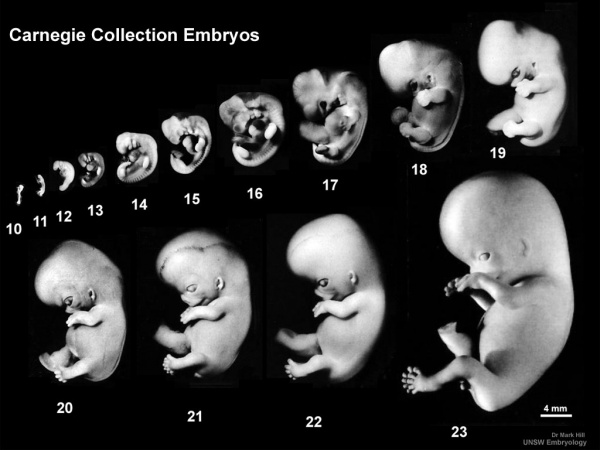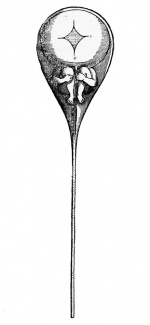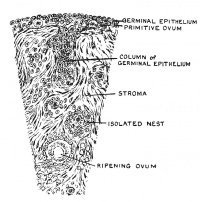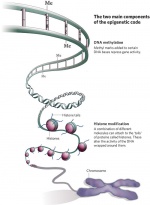|
|
| Line 4: |
Line 4: |
| ==Introduction== | | ==Introduction== |
| {| | | {| |
| | valign=top|All human and animal embryos go through very similar stages of early development. | | | valign=top|All human and animal embryos go through very similar stages of early development. See also [[K12 Human and Other Animal Development|Humans and Animal Embryology]]. |
|
| |
|
| The major difference appears to be how long it takes to reach each of these same stages.
| | What are the key things in development that we share? |
| | |
| We now also know that many of the underlying signals that regulate development are the same between these different species.
| |
| | |
| This page will introduce how we can compare the development of different animal embryos.
| |
|
| |
|
| | This page introduces a few of the concepts of development shared with all animals. |
|
| |
|
|
| |
|
| Line 52: |
Line 49: |
| |} | | |} |
|
| |
|
|
| |
| {| class="wikitable mw-collapsible mw-collapsed"
| |
| ! Exercise 1 - Embryo Size
| |
| |-
| |
| | colspan="2"|[[File:Mark_Hill.jpg|50px]] '''How big is the human embryo?''' [[Media:K12_Comparative_Embryology_Exercise_1.pdf|Download and Print the Worksheet]]
| |
|
| |
| # Open the image above on a new page and draw up a table with 3 columns (Stage, Size, Week).
| |
| # Fill in the Stage column 10 to 23 from the information in the picture.
| |
| # Put a ruler or use piece of paper to mark the 4mm scale bar.
| |
| # Now measure the size of each embryo and fill in the second table column.
| |
| # Finally, get the students to look on the site to identify the range of stages that occur in each week and fill in the third table column.
| |
|
| |
| |}
| |
|
| |
|
| |
| ===Week 4 to 5===
| |
| This is what the human embryo looks like at the end of week 4 and the beginning of week 5 development (called [[Carnegie stage 13]]) about half way through embryonic development.
| |
| {|
| |
| | [[File:Stage13_crown_rump_length.jpg|300px]]
| |
| | [[File:Stage13_surface_bulges.jpg|350px]]
| |
| |-
| |
| | Measuring embryo size (Crown Rump Length)
| |
| | Surface bulges (internal and external development)
| |
| |}
| |
|
| |
| :'''Links:''' [[Carnegie_stage_table|Carnegie Stages]]
| |
|
| |
| == Species Comparison of Carnegie Stages ==
| |
|
| |
| This table shows a comparison between different animal embryos and human embryos using the same staging criteria. Note that researchers have also developed embryo staging criteria that is specific to a single species.
| |
|
| |
| [[File:Carnegie stages species comparison.jpg]]
| |
|
| |
| {| class="wikitable mw-collapsible mw-collapsed"
| |
| ! Exercise 2 - Embryo Stages Comparison
| |
| |-
| |
| | colspan="2"|[[File:Mark_Hill.jpg|50px]] '''How long do different species take to reach the same stage of development?''' [[Media:K12_Comparative_Embryology_Exercise_2.pdf|Download and Print the Worksheet]]
| |
|
| |
| # Download and print the linked file.
| |
| # Use the graph as a guide to complete the table.
| |
| # Colour the stage table to show each developmental week range for each species over the weeks 1 to 8. (The chicken has been given as an example in the table)
| |
|
| |
|
| |
| |}
| |
|
| |
| :'''Links:''' [[Animal Development]] | [[Carnegie_Stage_Comparison|Comparative Development]] | [[:Template:CarnegieComparisonHRM|Comparing Human Rat and Mouse]]
| |
|
| |
| ==Human and Mouse Embryo==
| |
| The images below show a human and mouse embryo that appear externally close to the same stage of development.
| |
|
| |
| :''Would you know which was which without the labels?''
| |
|
| |
| ===Human===
| |
| [[File:Stage16 bf7.jpg|200px]] [[File:Stage16 bf5.jpg|200px]] [[File:Stage16 bf6.jpg|200px]] [[File:Stage16 bf8.jpg|200px]]
| |
|
| |
| 37 - 42 days, Week 6, 8 - 11 mm CRL (Carnegie stage 16)
| |
|
| |
| ===Mouse===
| |
| [[File:Mouse_CT_axes_E11.5.jpg|800px]]
| |
|
| |
| 11.5 days, Week 2, 6 - 7 mm CRL (Theiler Stage 19)
| |
|
| |
| {| class="wikitable mw-collapsible mw-collapsed"
| |
| ! Exercise 3 - Embryo Comparison
| |
| |-
| |
| | colspan="2"|[[File:Mark_Hill.jpg|50px]] '''What features do different embryos share?''' [[Media:K12_Comparative_Embryology_Exercise_3.pdf|Download and Print the Worksheet]]
| |
|
| |
| The images below show the 4 views of the same embryo at about the same external stage of development.
| |
| * The human embryo - photographs from the historic Carnegie collection early 1900’s.
| |
| * The mouse embryo - recent magnetic resonance images (MRI) from a 2006 research paper.
| |
|
| |
| # Both embryos are shown at about the same size (magnification). What is the actual difference in size between these two embryos?
| |
| # How many days difference are there between the mouse and human embryo to reach the same external appearance?
| |
| # Label the common external features you can identify on both embryos.
| |
| # What is the embryonic origin of the outer surface (skin) of both embryos?
| |
| |}
| |
|
| |
| ==Early Development==
| |
| {| class="wikitable mw-collapsible mw-collapsed"
| |
| ! Teacher Note
| |
| |-
| |
| | colspan="2"|[[File:Mark_Hill.jpg|50px]] '''Early Embryo Development.'''
| |
|
| |
| This process occurs before the above embryo stages. I have placed it after them on this page as it is a more abstract concept, while the external appearance of the embryos is easier for students to initially understand and relate too.
| |
|
| |
|
| |
| |}
| |
| {|
| |
| | valign=top|
| |
| '''All vertebrate embryos initially form the same 3 germ layers.'''
| |
|
| |
| During the third week of human embryonic development, the following layers form and will eventually differentiate and form specific adult tissues (some examples are shown in the cartoon and below).
| |
|
| |
| Germ Layers:
| |
| # '''Ectoderm''' - epidermis of skin (outer layer of skin) and nervous system.
| |
| # '''Mesoderm''' - connective tissues (bone, muscle, cartilage, blood)
| |
| # '''Endoderm''' - lining of the gut, lungs, endocrine organs.
| |
|
| |
|
| |
|
| |
| {| class="wikitable mw-collapsible mw-collapsed"
| |
| ! Exercise 4 - Early Embryos
| |
| |-
| |
| | colspan="2"|[[File:Mark_Hill.jpg|50px]] '''What features are common in early development?'''
| |
|
| |
| (worksheet under preparation, based on cartoon of germ cell layers)
| |
|
| |
| '''Note'''
| |
| * These same three layers will form the same adult tissues in all mammalian, and more widely vertebrate (animals with a backbone), embryos.
| |
| ** The term "germ layers" refers to the fact that cell layers will form '''all adult tissues'''.
| |
| ** The term should not be confused with "germ cells", which refers to the cells that will form either '''eggs''' or '''spermatozoa'''.
| |
| ** The term "derm" means '''skin''' as in a layer.
| |
| * The layers form by a process called '''gastrulation'''.
| |
| ** This is therefore called the gastrula stage.
| |
| ** These are temporary layers and do not exist as layers in either the later embryo or adult.
| |
| * Gastrulation will occur at different times in different species embryos.
| |
| ** In humans, this occurs about 3 weeks after fertilisation and also after implantation in the uterus.
| |
| |}
| |
| | [[File:Inner cell mass cartoon.jpg|500px]]
| |
| |}
| |
|
| |
| ==Limb Comparative Anatomy==
| |
| [[File:Limb comparison cartoon 02.jpg|600px|alt=Limb comparison cartoon]]
| |
|
| |
| This cartoon shows the comparative anatomy of bones within the upper limb of 4 different species.
| |
|
| |
| Each limb is significantly different in size and function, but all contain the same basic skeletal structures.
| |
|
| |
| ==Animal Development==
| |
|
| |
| The table below lists the approximate development time for a large number of different animals, ranging from the opossum at 12 days to the elephant at 660 days.
| |
|
| |
| {{Animal development period table}}
| |
|
| |
| [[File:Frog_lifecycle.jpg]]
| |
|
| |
| [[File:Timeline_rabbit.JPG]]
| |
|
| |
| {| class="wikitable mw-collapsible mw-collapsed"
| |
| ! Teacher Note
| |
| |-
| |
| | colspan="2"|[[File:Mark_Hill.jpg|50px]] Currently only a series of related images.
| |
|
| |
| I am writing explanatory notes and associated exercises for this section when I have some spare time. You can also let your students look at the animal pages designed by my students back in 2009. Each page includes images of the embryos and a timeline of development for each animal embryo.
| |
|
| |
| These are university undergraduate student designed pages describing the development of specific animal embryos.
| |
|
| |
| {{Projects09}}
| |
|
| |
| |}
| |
|
| |
| {| class="wikitable mw-collapsible mw-collapsed"
| |
| ! Teacher Note
| |
| |-
| |
| | colspan="2"|[[File:Mark_Hill.jpg|50px]] '''Comparative Embryology''' - Links out to other resources.
| |
|
| |
| {{K12_worksheet}}
| |
|
| |
| Additional worksheets are currently being developed.
| |
|
| |
| These links below are not yet organised in a way that students can easily use (content level and navigation) bookmark this current page or use the browser back button.
| |
|
| |
| Look through the stages and tables and think about designing exercises comparing the different species.
| |
|
| |
| * [[Fly Development|Fly]]: [[2009_Group_Project_2#Stages_of_Drosophila_Embryological_Development|Fly Stages]]
| |
| * [[Zebrafish Development|Zebrafish]]: [[2009_Group_Project_3#Timeline_and_Stages_of_Embryonic_Development|Zebrafish Stages]]
| |
| * [[Chicken Development|Chicken]]: [[Chicken stages]] | [[Hamburger Hamilton Stages]] | [[Witschi Stages]]
| |
| * [[Mouse Development|Mouse]]: [[2009_Group_Project_4#Staging_Of_Embryonic_Development|Mouse Stages]]
| |
| * [[Rat Development|Rat]]: [[Rat Development Stages]]
| |
| * [[Rabbit Development|Rabbit]]: [[2009_Group_Project_1#Staging|Rabbit Stages]]
| |
|
| |
| {{Animals}}
| |
|
| |
| |}
| |
| ==Developmental Misconceptions== | | ==Developmental Misconceptions== |
| Many of these are truely historic, and while essentially wrong, science works through testing these alternate theories, and is some cases some can even be partially correct. | | Many of these are truely historic, and while essentially wrong, science works through testing these alternate theories, and is some cases some can even be partially correct. |




